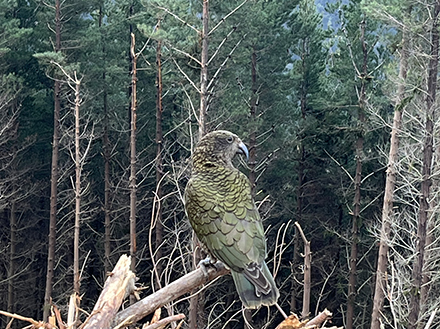
A preliminary study has been published documenting kea habitat use, movement and diet in forestry company OneFortyOne’s forests in the Nelson Tasman region of New Zealand. Source: Timberbiz
The study, conducted by Lincoln University Masters student Jodanne Aitken, and funded by forestry company OneFortyOne, confirmed that kea are residing and utilising food sources within pine plantation forests in the Nelson Tasman region.
Aitken said very little is known about kea occupancy, behavioural ecology or habitat use of plantation forests.
“It’s a preliminary study, which gives us a better insight into kea beahviour in pine plantation forests and help us understand what might be keeping them in the pine forests,” said Ms Aitken.
“It is thought kea may utilise plantation sites to forage for seeds and insects and could possibly even seek out plantation sites at particular phases of forestry activities, for example immediately post-harvest to find specific food items.
“The study used GPS-VHF units to track the movements of three kea through the forestry blocks, I also recorded feeding observations of kea in the forest.”
Ms Aitken noted the kea in OneFortyOne’s forest were different to those she had previously studied further south.
As a PhD student, it’s not often you’re outsmarted by your study species, but Ms Aitken said the kea in the Nelson Tasman forests were the hardest birds to catch out of all kea in the country.
“It took almost four months to lure the birds in,” she said.
“The kea studied tended to sit up in the trees more and are not observed on the ground as often. This behaviour is similar to what we would see in Okarito in the West Coast, the diet was also similar with them eating mostly invertebrates and seeds.”
“Understanding kea use of plantation forestry sites is vital for guiding effective conservation management strategies and ensuring that no negative interactions occur between kea and forestry workers and their equipment.
“The numbers of kea are sadly low (~5000-7000 kea remaining), we need to understand them better in all their environments to conserve them.”
“It would be great to see more large land users replicate the investment OneFortyOne has made, we all need to work together to protect these beautiful and extremely clever birds,” said Ms Aitken.
OneFortyOne has contributed NZ$100,000 to a suite of Kea Conservation Trust projects, including this study focused on kea habitat use and diet in plantation forests.





